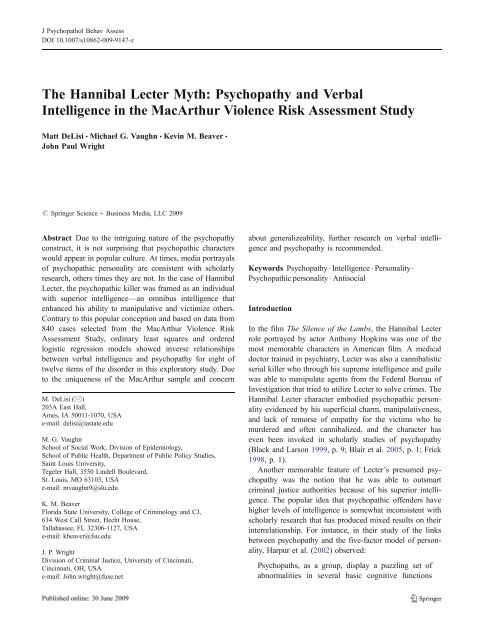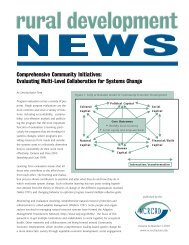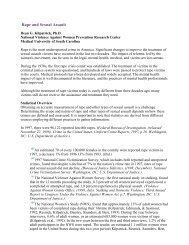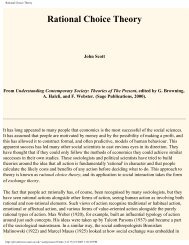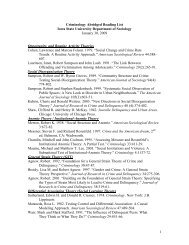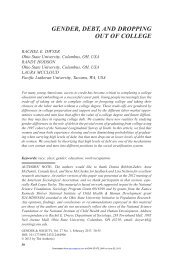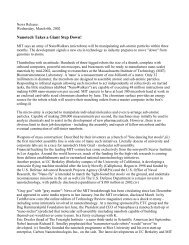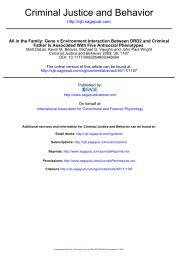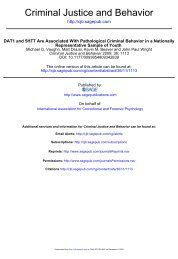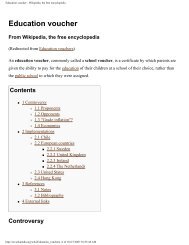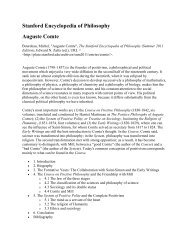The Hannibal Lecter Myth: Psychopathy and Verbal Intelligence in ...
The Hannibal Lecter Myth: Psychopathy and Verbal Intelligence in ...
The Hannibal Lecter Myth: Psychopathy and Verbal Intelligence in ...
You also want an ePaper? Increase the reach of your titles
YUMPU automatically turns print PDFs into web optimized ePapers that Google loves.
J Psychopathol Behav Assess<br />
DOI 10.1007/s10862-009-9147-z<br />
<strong>The</strong> <strong>Hannibal</strong> <strong>Lecter</strong> <strong>Myth</strong>: <strong>Psychopathy</strong> <strong>and</strong> <strong>Verbal</strong><br />
<strong>Intelligence</strong> <strong>in</strong> the MacArthur Violence Risk Assessment Study<br />
Matt DeLisi & Michael G. Vaughn & Kev<strong>in</strong> M. Beaver &<br />
John Paul Wright<br />
# Spr<strong>in</strong>ger Science + Bus<strong>in</strong>ess Media, LLC 2009<br />
Abstract Due to the <strong>in</strong>trigu<strong>in</strong>g nature of the psychopathy<br />
construct, it is not surpris<strong>in</strong>g that psychopathic characters<br />
would appear <strong>in</strong> popular culture. At times, media portrayals<br />
of psychopathic personality are consistent with scholarly<br />
research, others times they are not. In the case of <strong>Hannibal</strong><br />
<strong>Lecter</strong>, the psychopathic killer was framed as an <strong>in</strong>dividual<br />
with superior <strong>in</strong>telligence—an omnibus <strong>in</strong>telligence that<br />
enhanced his ability to manipulative <strong>and</strong> victimize others.<br />
Contrary to this popular conception <strong>and</strong> based on data from<br />
840 cases selected from the MacArthur Violence Risk<br />
Assessment Study, ord<strong>in</strong>ary least squares <strong>and</strong> ordered<br />
logistic regression models showed <strong>in</strong>verse relationships<br />
between verbal <strong>in</strong>telligence <strong>and</strong> psychopathy for eight of<br />
twelve items of the disorder <strong>in</strong> this exploratory study. Due<br />
to the uniqueness of the MacArthur sample <strong>and</strong> concern<br />
M. DeLisi (*)<br />
203A East Hall,<br />
Ames, IA 50011-1070, USA<br />
e-mail: delisi@iastate.edu<br />
M. G. Vaughn<br />
School of Social Work, Division of Epidemiology,<br />
School of Public Health, Department of Public Policy Studies,<br />
Sa<strong>in</strong>t Louis University,<br />
Tegeler Hall, 3550 L<strong>in</strong>dell Boulevard,<br />
St. Louis, MO 63103, USA<br />
e-mail: mvaughn9@slu.edu<br />
K. M. Beaver<br />
Florida State University, College of Crim<strong>in</strong>ology <strong>and</strong> CJ,<br />
634 West Call Street, Hecht House,<br />
Tallahassee, FL 32306-1127, USA<br />
e-mail: kbeaver@fsu.edu<br />
J. P. Wright<br />
Division of Crim<strong>in</strong>al Justice, University of C<strong>in</strong>c<strong>in</strong>nati,<br />
C<strong>in</strong>c<strong>in</strong>nati, OH, USA<br />
e-mail: John.wright@fuse.net<br />
about generalizeability, further research on verbal <strong>in</strong>telligence<br />
<strong>and</strong> psychopathy is recommended.<br />
Keywords <strong>Psychopathy</strong> . <strong>Intelligence</strong> . Personality .<br />
Psychopathic personality . Antisocial<br />
Introduction<br />
In the film <strong>The</strong> Silence of the Lambs, the <strong>Hannibal</strong> <strong>Lecter</strong><br />
role portrayed by actor Anthony Hopk<strong>in</strong>s was one of the<br />
most memorable characters <strong>in</strong> American film. A medical<br />
doctor tra<strong>in</strong>ed <strong>in</strong> psychiatry, <strong>Lecter</strong> was also a cannibalistic<br />
serial killer who through his supreme <strong>in</strong>telligence <strong>and</strong> guile<br />
was able to manipulate agents from the Federal Bureau of<br />
Investigation that tried to utilize <strong>Lecter</strong> to solve crimes. <strong>The</strong><br />
<strong>Hannibal</strong> <strong>Lecter</strong> character embodied psychopathic personality<br />
evidenced by his superficial charm, manipulativeness,<br />
<strong>and</strong> lack of remorse of empathy for the victims who he<br />
murdered <strong>and</strong> often cannibalized, <strong>and</strong> the character has<br />
even been <strong>in</strong>voked <strong>in</strong> scholarly studies of psychopathy<br />
(Black <strong>and</strong> Larson 1999, p. 9; Blair et al. 2005, p. 1; Frick<br />
1998, p. 1).<br />
Another memorable feature of <strong>Lecter</strong>’s presumed psychopathy<br />
was the notion that he was able to outsmart<br />
crim<strong>in</strong>al justice authorities because of his superior <strong>in</strong>telligence.<br />
<strong>The</strong> popular idea that psychopathic offenders have<br />
higher levels of <strong>in</strong>telligence is somewhat <strong>in</strong>consistent with<br />
scholarly research that has produced mixed results on their<br />
<strong>in</strong>terrelationship. For <strong>in</strong>stance, <strong>in</strong> their study of the l<strong>in</strong>ks<br />
between psychopathy <strong>and</strong> the five-factor model of personality,<br />
Harpur et al. (2002) observed:<br />
Psychopaths, as a group, display a puzzl<strong>in</strong>g set of<br />
abnormalities <strong>in</strong> several basic cognitive functions
<strong>in</strong>volved <strong>in</strong> attention, impulse control, <strong>and</strong> the process<strong>in</strong>g<br />
of affect <strong>and</strong> language. <strong>The</strong>se may represent critical<br />
additional risk factors for the development of the<br />
disorder <strong>in</strong> addition to, or <strong>in</strong> comb<strong>in</strong>ation with, the<br />
underly<strong>in</strong>g personality structure (p. 320).<br />
Given the differ<strong>in</strong>g academic <strong>and</strong> even popular conceptualizations<br />
of the l<strong>in</strong>k between psychopathy <strong>and</strong><br />
<strong>in</strong>telligence, the current study evaluated the putative<br />
association between verbal <strong>in</strong>telligence <strong>and</strong> psychopathic<br />
personality.<br />
<strong>Psychopathy</strong> <strong>and</strong> <strong>Intelligence</strong><br />
Cl<strong>in</strong>ical op<strong>in</strong>ion about the <strong>in</strong>telligence of psychopaths has<br />
varied. In his sem<strong>in</strong>al work, Cleckley (1941) described the<br />
psychopath as be<strong>in</strong>g more clever than average <strong>and</strong><br />
possess<strong>in</strong>g superior general <strong>in</strong>telligence, these traits facilitated<br />
their superficial, glib <strong>in</strong>terpersonal style <strong>and</strong> ability to<br />
manipulative others. This manipulation extended to the<br />
crim<strong>in</strong>al justice system. Accord<strong>in</strong>g to Cleckley (1941):<br />
He is also dist<strong>in</strong>guished by his ability to escape<br />
ord<strong>in</strong>ary legal punishments <strong>and</strong> restra<strong>in</strong>ts. Though he<br />
regularly makes trouble for society, as well as for<br />
himself, <strong>and</strong> frequently is h<strong>and</strong>led by the police, his<br />
characteristic behavior does not usually <strong>in</strong>clude<br />
committ<strong>in</strong>g felonies which would br<strong>in</strong>g about permanent<br />
or adequate restrictions of his activities. He is<br />
often arrested, perhaps one hundred time or more. But<br />
he nearly always rega<strong>in</strong>s his freedom <strong>and</strong> returns to<br />
his old patterns of maladjustment (p. 19).<br />
Although his own conceptualization of psychopathy was<br />
<strong>in</strong>fluenced by Cleckley, Hare’s approach represents a<br />
disjuncture from Cleckley on the <strong>in</strong>telligence issue. It is<br />
possible that Cleckley’s use of <strong>in</strong>telligence was affected by<br />
his cl<strong>in</strong>ical sample which <strong>in</strong>cluded disproportionately welleducated,<br />
middle- <strong>and</strong> upper-middle class persons. It is<br />
ma<strong>in</strong>ta<strong>in</strong>ed that relationships between <strong>in</strong>telligence measures<br />
<strong>and</strong> the <strong>Psychopathy</strong> Checklist Revised (PCL-R: Hare<br />
1991, 2003) are generally weak, <strong>and</strong> there is little reason<br />
to believe that psychopathic <strong>in</strong>dividuals possess superior<br />
<strong>in</strong>telligence (Hare <strong>and</strong> Neumann 2008, pp. 226–227).<br />
Indeed, Salek<strong>in</strong> et al. (2004) concluded that “Despite<br />
widespread adoption of the connection between psychopathy<br />
<strong>and</strong> <strong>in</strong>telligence dur<strong>in</strong>g Cleckley’s era, today’s notion of<br />
psychopathy is no longer explicitly l<strong>in</strong>ked to good<br />
<strong>in</strong>telligence” (p. 740).<br />
Empirical research has produced conflict<strong>in</strong>g f<strong>in</strong>d<strong>in</strong>gs on<br />
the <strong>in</strong>terrelationships between the different facets of<br />
psychopathy (e.g., <strong>in</strong>terpersonal, affective, behavioral, <strong>and</strong><br />
lifestyle) <strong>and</strong> types of <strong>in</strong>telligence <strong>and</strong> cognitive maturity<br />
J Psychopathol Behav Assess<br />
(Mull<strong>in</strong>-Nelson et al. 2006; Salek<strong>in</strong> et al. 2002). Based on<br />
data from 40 patients liv<strong>in</strong>g <strong>in</strong> a psychiatric hospital,<br />
O’Kane et al. (1996) reported a significant correlation<br />
between Total PCL-R score <strong>and</strong> IQ (r=−.42, p=.005) <strong>and</strong><br />
Factor 1 PCL-R <strong>and</strong> IQ (r=−.49, p=.005) which encompasses<br />
the <strong>in</strong>terpersonal <strong>and</strong> affective dimensions of the<br />
disorder. <strong>The</strong>re was not a significant relationship between<br />
Factor 2 PCL-R score <strong>and</strong> IQ (r=−.05, p = ns) which spans<br />
the lifestyle <strong>and</strong> behavioral aspects of psychopathy. Based<br />
on data from a sample of 122 youths housed <strong>in</strong> a<br />
juvenile detention facility, Salek<strong>in</strong> et al. (2004) usedthe<br />
<strong>Psychopathy</strong> Checklist-Youth Version (PCL-YV: Forth et<br />
al. 2003), Kaufman’s Brief <strong>Intelligence</strong> Test (K-BIT:<br />
Kaufman <strong>and</strong> Kaufman 1990), <strong>and</strong> Sternberg’s Triarchic<br />
Abilities Test (STAT—High School Level: Sternberg,<br />
Unpublished) to <strong>in</strong>vestigate the l<strong>in</strong>kages between psychopathy<br />
<strong>and</strong> <strong>in</strong>telligence. <strong>The</strong>y found that youths who<br />
scored high on the arrogant <strong>and</strong> deceitful <strong>in</strong>terpersonal<br />
scale had greater verbal abilities <strong>and</strong> overall <strong>in</strong>telligence<br />
than other del<strong>in</strong>quents. Moreover, the comb<strong>in</strong>ation of<br />
creative, practical, <strong>and</strong> analytical <strong>in</strong>telligence was higher<br />
<strong>in</strong> psychopathic del<strong>in</strong>quents (r=.22, p
J Psychopathol Behav Assess<br />
which facet of the disorder is considered. <strong>The</strong>re is also<br />
evidence that different subsamples of crim<strong>in</strong>al offenders<br />
present different portraits of a l<strong>in</strong>k between IQ <strong>and</strong><br />
psychopathy. For <strong>in</strong>stance, Johansson <strong>and</strong> Kerr (2005)<br />
studied 370 violent male prisoners <strong>and</strong> found that higher<br />
verbal <strong>in</strong>telligence served as a protective factor for<br />
crim<strong>in</strong>als which resulted <strong>in</strong> delayed onset of offend<strong>in</strong>g.<br />
However, among psychopathic males with high <strong>in</strong>telligence<br />
scores, the onset of offend<strong>in</strong>g was earlier. In a sample of<br />
216 male child molesters, Beggs <strong>and</strong> Grace (2008) reported<br />
an overall correlation between IQ <strong>and</strong> psychopathy as<br />
measured by the PCL-R of (r=0.20, p
levels of psychopathy. Previous research has shown the PCL:<br />
SV to be a predictor of future violent behavior <strong>in</strong> this sample<br />
(Skeem <strong>and</strong> Mulvey 2001). Internal consistency reliability <strong>in</strong><br />
the present study sample was adequate (α=.84). Prior<br />
research (e.g., Vitacco et al. 2005) found structural <strong>in</strong>variance<br />
for the PCL: SV on the basis of ethnicity thus it is<br />
useful for both African-Americans <strong>and</strong> Caucasians. <strong>The</strong>re is<br />
considerable debate about the structure of the psychopathy<br />
construct <strong>and</strong> whether it is best constituted by two, three, or<br />
four factors (Cooke <strong>and</strong> Michie 2001; Hare <strong>and</strong> Neumann<br />
2008; Vitacco et al. 2005); however evaluat<strong>in</strong>g this empirical<br />
question is not our current focus.<br />
Independent Variables<br />
<strong>Verbal</strong> IQ <strong>Verbal</strong> IQ skills (M=34.67, SD=16.56) were<br />
assessed us<strong>in</strong>g the Wechsler Adult <strong>Intelligence</strong> Scale—<br />
Revised (WAIS-R; Wechsler 1999) vocabulary subtest,<br />
which is comprised of 35 items (α=.93) that correlates<br />
strongly with the Full IQ score. <strong>The</strong> WAIS-R was normed<br />
on a representative sample of 1,800 American adults, is<br />
strongly correlated with other IQ tests (e.g., Stanford-<br />
B<strong>in</strong>et), <strong>and</strong> has demonstrated excellent psychometric<br />
properties (Reynolds et al. 1983; Wechsler 1999). It is<br />
important to po<strong>in</strong>t out that the performance IQ component<br />
was unavailable.<br />
Impulsivity Impulsivity is an important theoretical construct<br />
that is central to general theories of antisocial behavior (e.g.,<br />
Gottfredson <strong>and</strong> Hirschi 1990; Moffitt 1993b) <strong>and</strong> was<br />
<strong>in</strong>cluded as a statistical control. Impulsivity was assess<strong>in</strong>g<br />
us<strong>in</strong>g the Barratt Impulsivity Scale (BIS) (Barratt 1965,<br />
1994), one of the most widely used self-adm<strong>in</strong>istered<br />
measures of impulsivity. <strong>The</strong> BIS conceptualizes impulsivity<br />
as consist<strong>in</strong>g of three ma<strong>in</strong> doma<strong>in</strong>s: motor (M=18.05, SD=<br />
7.7), cognitive (M=15.48, SD=5.65), <strong>and</strong> non-plann<strong>in</strong>g (M=<br />
23.91, SD=7.51). <strong>The</strong> BIS consists of 30 items to which the<br />
study participant responds “rarely/never, occasionally, often or<br />
almost always/always.” Patton et al. (1995) reported <strong>in</strong>ternal<br />
consistency coefficients for the BIS total score rang<strong>in</strong>g from<br />
(α=0.79 to 0.83) across samples of undergraduates,<br />
substance-abus<strong>in</strong>g patients, general psychiatric patients, <strong>and</strong><br />
prison <strong>in</strong>mates. For the purposes of this study we used each of<br />
the three doma<strong>in</strong> scores <strong>and</strong> not the total score.<br />
Demographics Age, ethnicity, gender, race <strong>and</strong> socioeconomic<br />
status were <strong>in</strong>cluded as controls. Socioeconomic<br />
status was coded us<strong>in</strong>g Holl<strong>in</strong>gshead <strong>and</strong> Redlich’s (1958)<br />
Socioeconomic status <strong>in</strong>dex (M=64.56, SD=11.8). This<br />
<strong>in</strong>dex has been widely used <strong>in</strong> the psychiatric <strong>and</strong><br />
sociological literature to assess socioeconomic status <strong>and</strong><br />
adjusts for education <strong>and</strong> occupation prior to hospitalization<br />
to formulate a composite socioeconomic status rat<strong>in</strong>g with<br />
higher rat<strong>in</strong>gs reflect<strong>in</strong>g higher socioeconomic levels.<br />
Statistical Analyses<br />
<strong>The</strong> analytic plan proceeds <strong>in</strong> several steps that use the<br />
PCL: SV total score <strong>and</strong> items as dependent variables. First,<br />
we conduct ord<strong>in</strong>ary least squares regression predict<strong>in</strong>g<br />
total PCL: SV score with verbal IQ, demographic factors<br />
<strong>and</strong> measures of impulsivity. Next, we extend previous<br />
work (Salek<strong>in</strong> et al. 2004; Vitacco et al. 2005) by<br />
evaluat<strong>in</strong>g the effect of verbal IQ on each psychopathy<br />
facet (i.e., <strong>in</strong>dividual item) by employ<strong>in</strong>g a series of twelve<br />
ordered logistic regressions (PCL: SV item one thru item<br />
twelve) while controll<strong>in</strong>g for demographic factors (i.e., age,<br />
SES, gender, race) <strong>and</strong> specific components of impulsivity<br />
previously described. Ordered logistic regression is necessary<br />
given the response format of each <strong>in</strong>dividual PCL: SV<br />
item (0–2) with higher scores reflect<strong>in</strong>g the presence of the<br />
trait to a greater degree. Ordered logistic regression is a<br />
maximum likelihood technique that provides probability<br />
estimates across an ord<strong>in</strong>al scale. Ordered logistic regressions<br />
were executed us<strong>in</strong>g the computer software package<br />
Stata 10SE. Any miss<strong>in</strong>g cases were assumed to be miss<strong>in</strong>g<br />
at r<strong>and</strong>om <strong>and</strong> were imputed us<strong>in</strong>g an expectation maximization<br />
algorithm. See Appendix for correlation matrix.<br />
Results<br />
Prediction of PCL: SV Total Score<br />
<strong>The</strong> first set of analyses regressed the PCL: SV total score on<br />
verbal IQ while controll<strong>in</strong>g for demographic factors (age,<br />
gender, race, <strong>and</strong> SES) <strong>and</strong> BIS motor, non-plann<strong>in</strong>g <strong>and</strong><br />
cognitive impulsivity doma<strong>in</strong>s. As revealed <strong>in</strong> Table 1 the<br />
overall model (F [8, 831]=26.48, p
J Psychopathol Behav Assess<br />
Table 1 Results from OLS regression predict<strong>in</strong>g PCL: SV total score<br />
(N=840)<br />
PCL: SV total score b βeta SE 95% CI<br />
Age −.01 −.01 .03 −.057, .051<br />
Male gender 1.92 .17*** .35 1.20, 2.59<br />
Socioeconomic status .06 .13*** .01 .029, .089<br />
Race .71 .07 .41 −.093, 1.504<br />
BIS motor .10 .13** .03 .037, .152<br />
BIS non-plann<strong>in</strong>g .14 .20*** .03 .088, .202<br />
BIS cognitive −.04 −.04 .04 −.112, .038<br />
IQ verbal −.05 −.14*** .01 −.072, −.023<br />
Model F (8, 831)=26.48, p
Table 3 Results from ordered logistic regressions predict<strong>in</strong>g lacks remorse, lacks empathy, doesn’t accept responsibility, <strong>and</strong> adolescent antisocial<br />
behavior (N=840)<br />
Variable Lacks remorse Lacks empathy Doesn’t accept responsibility Adolescent antisocial behavior<br />
OR SE OR SE OR SE OR SE<br />
Socioeconomic status 1.02** .007 1.02** .007 1.01 .006 1.02* .006<br />
Age .984 .010 .987 .011 1.00 .010 .967** .010<br />
Gender (male) 1.66** .243 1.69*** .249 1.62*** .221 1.76*** .250<br />
Race 1.21 .171 1.13 .164 1.24 .176 1.09 .159<br />
BIS motor 1.03* .012 1.01 .011 1.02* .010 1.02* .010<br />
BIS non-plann<strong>in</strong>g 1.01 .011 1.01 .011 1.02* .011 1.04** .011<br />
BIS cognitive .981 .016 .980 .015 1.00 .014 1.01 .014<br />
<strong>Verbal</strong> IQ .989* .005 .986** .005 .984** .004 .992 .005<br />
*p
J Psychopathol Behav Assess<br />
function<strong>in</strong>g <strong>and</strong> broad life failure. However, specific traits<br />
such as obsessive–compulsiveness <strong>and</strong> narcissism were<br />
positively associated with status <strong>and</strong> wealth. In this way,<br />
narcissism—a core psychopathy trait—can appear to be a<br />
source of <strong>in</strong>telligence when it results <strong>in</strong> a highly motivated/<br />
driven work style that results <strong>in</strong> higher earn<strong>in</strong>gs. Indeed,<br />
Paulhus <strong>and</strong> Williams (2002) reported a significant correlation<br />
between narcissism <strong>and</strong> IQ (r=.15, p
Appendix 1: Correlation Matrix of Study Variables<br />
1 2 3 4 5 6 7<br />
1. Age 1.00<br />
2. SES −0.01 1.00<br />
3. PCL: SV total −0.04 0.24*** 1.00<br />
4. BIS Motor −0.19*** 0.14*** 0.25 1.00<br />
5. BIS Non-plann<strong>in</strong>g 0.01 0.14*** 0.29*** 0.44*** 1.00<br />
6. BIS Cognitive −0.08** 0.23*** 0.16*** 0.50*** 0.49*** 1.00<br />
7. <strong>Verbal</strong> IQ 0.10** −0.41*** −0.25*** −0.21*** −0.09** −0.19*** 1.00<br />
*p
J Psychopathol Behav Assess<br />
Kaufman, A. S., & Kaufman, N. L. (1990). Kaufman brief <strong>in</strong>telligence<br />
test (K-BIT). Circle P<strong>in</strong>es, MN: American Guidance Service.<br />
Loney, B. R., Frick, P. J., Ellis, M., & McCoy, M. G. (1998). <strong>Intelligence</strong>,<br />
callous-unemotional traits, <strong>and</strong> antisocial behavior. Journal of<br />
Psychopathology <strong>and</strong> Behavioral Assessment, 20, 231–247.<br />
Luria, A. R. (1961). <strong>The</strong> role of speech <strong>in</strong> the regulation of normal<br />
<strong>and</strong> abnormal behavior. New York: Basic Books.<br />
McGlo<strong>in</strong>, J. M., Pratt, T. C., & Maahs, J. (2004). Reth<strong>in</strong>k<strong>in</strong>g the IQdel<strong>in</strong>quency<br />
relationship: a longitud<strong>in</strong>al analysis of multiple<br />
theoretical models. Justice Quarterly, 21, 603–636.<br />
Moffitt, T. E. (1993a). <strong>The</strong> neuropsychology of conduct disorder.<br />
Development <strong>and</strong> Psychopathology, 5, 135–151.<br />
Moffitt, T. E. (1993b). Adolescence-limited <strong>and</strong> life-course persistent<br />
antisocial behavior: a developmental taxonomy. Psychological<br />
Review, 100, 674–701.<br />
Monahan, J., Steadman, H., Silver, E., Appelbaum, P., Robb<strong>in</strong>s, P.,<br />
Mulvey, E., et al. (2001). Reth<strong>in</strong>k<strong>in</strong>g risk assessment: <strong>The</strong><br />
MacArthur study of mental disorder <strong>and</strong> violence. New York:<br />
Oxford University Press.<br />
Mull<strong>in</strong>-Nelson, J. L., Salek<strong>in</strong>, R. T., & Leistico, A. R. (2006).<br />
<strong>Psychopathy</strong>, empathy, <strong>and</strong> perspective-tak<strong>in</strong>g ability <strong>in</strong> a<br />
community sample: implications for the successful psychopathy<br />
concept. International Journal of Forensic Mental Health, 5,<br />
133–149.<br />
O’Kane, A., Fawcett, D., & Blackburn, R. (1996). <strong>Psychopathy</strong> <strong>and</strong><br />
moral reason<strong>in</strong>g: comparison of two classifications. Personality<br />
<strong>and</strong> Individual Differences, 20, 515–514.<br />
Patton, J., St<strong>and</strong>ford, M., & Barratt, E. (1995). <strong>The</strong> factor structure of<br />
the Barratt impulsiveness scale. Journal of Cl<strong>in</strong>ical Psychology,<br />
51, 768–775.<br />
Paulhus, D. L., & Williams, K. M. (2002). <strong>The</strong> dark triad of<br />
personality: narcissism, Machiavellianism, <strong>and</strong> psychopathy.<br />
Journal of Research <strong>in</strong> Personality, 36, 556–563.<br />
Reynolds, C. R., Willson, V. L., & Clark, P. L. (1983). A four-test<br />
short form of the WAIS-R for cl<strong>in</strong>ical screen<strong>in</strong>g. Cl<strong>in</strong>ical<br />
Neuropsychology, 5, 111–116.<br />
Salek<strong>in</strong>, R. T., Yff, R. M. A., Neumann, C. S., Leistico, A. R., &<br />
Zalot, A. A. (2002). Juvenile transfer to adult courts: a look at the<br />
prototypes for dangerousness, sophistication-maturity, <strong>and</strong> ame-<br />
nability to treatment through a legal lens. Psychology, Public<br />
Policy, <strong>and</strong> Law, 8, 373–410.<br />
Salek<strong>in</strong>, R. T., Neumann, C. S., Leistico, A. R., & Zalot, A. A. (2004).<br />
<strong>Psychopathy</strong> <strong>in</strong> youth <strong>and</strong> <strong>in</strong>telligence: an <strong>in</strong>vestigation of<br />
Cleckley’s hypothesis. Journal of Cl<strong>in</strong>ical Child <strong>and</strong> Adolescent<br />
Psychology, 33, 731–744.<br />
Skeem, J., & Mulvey, E. (2001). <strong>Psychopathy</strong> <strong>and</strong> community<br />
violence among civil psychiatric patients: results from the<br />
MacArthur violence risk assessment study. Journal of Consult<strong>in</strong>g<br />
<strong>and</strong> Cl<strong>in</strong>ical Psychology, 69, 358–374.<br />
Skeem, J. L., Miller, J. D., Mulvey, E., Tiemann, J., & Monahan,<br />
J. (2005). Us<strong>in</strong>g a five-factor lens to explore the relation<br />
between personality traits <strong>and</strong> violence <strong>in</strong> psychiatric<br />
patients. Journal of Consult<strong>in</strong>g <strong>and</strong> Cl<strong>in</strong>ical Psychology, 73,<br />
454–465.<br />
Steadman, H. J., Mulvey, E. P., Monahan, J., Robb<strong>in</strong>s, P. C., Appelbaum,<br />
P. S., Grisso, T., et al. (1998). Violence by people discharged from<br />
acute psychiatric <strong>in</strong>patient facilities <strong>and</strong> by others <strong>in</strong> the same<br />
neighborhoods. Archives of General Psychiatry, 55, 393–401.<br />
Ullrich, S., Farr<strong>in</strong>gton, D. P., & Coid, J. W. (2007). Dimensions of<br />
DSM-IV personality disorders <strong>and</strong> life-success. Journal of<br />
Personality Disorders, 21, 657–663.<br />
Vaughn, M. G., DeLisi, M., Beaver, K. M., Wright, J. P., & Howard,<br />
M. O. (2007). Toward a psychopathology of self-control theory:<br />
the importance of narcissistic traits. Behavioral Sciences <strong>and</strong> the<br />
Law, 25, 803–821.<br />
Vitacco, M. J., Neumann, C. S., & Jackson, R. L. (2005). Test<strong>in</strong>g a<br />
four-factor model of psychopathy <strong>and</strong> its association with<br />
ethnicity, gender, <strong>in</strong>telligence, <strong>and</strong> violence. Journal of Consult<strong>in</strong>g<br />
<strong>and</strong> Cl<strong>in</strong>ical Psychology, 73, 466–476.<br />
Vitacco, M. J., Neumann, C. S., & Wodushek, T. (2008). Differential<br />
relationships between the dimensions of psychopathy <strong>and</strong><br />
<strong>in</strong>telligence: replication with adult jail <strong>in</strong>mates. Crim<strong>in</strong>al Justice<br />
<strong>and</strong> Behavior, 35, 48–55.<br />
Wechsler, D. (1999). Wechsler abbreviated scale of <strong>in</strong>telligence. San<br />
Antonio, TX: <strong>The</strong> Psychological Corporation.<br />
Wilson, J. Q., & Herrnste<strong>in</strong>, R. J. (1985). Crime <strong>and</strong> human nature:<br />
<strong>The</strong> def<strong>in</strong>itive study of the causes of crime. New York: Simon <strong>and</strong><br />
Schuster.


